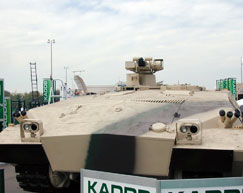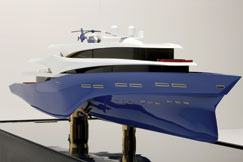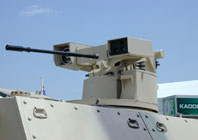At the world’s largest defence and security exhibition, DSEi, held at the London Excel centre, two giant halls display everything from tanks and armoured personnel carriers to helicopters and howitzers.
These are the biggest and baddest of all boys’ toys, but not everything is as it first appears. Nestled in-between the weapons on display are some imposters. And despite their fierce looks, the only harm these replicas could cause would be if you dropped them on your foot.

A manufacturer wanted to demonstrate a newly developed remote weapon station and needed a suitable canon to fit the gun mount. The M261 was identified as the weapon of choice, but it became obvious that they could not procure a real weapon because of the timescale and costs.
John Lawson located a working canon at the Defence Evaluation and Research Agency and took multiple measurements, sketches and photographs, before producing a CAD model that was used to manufacture the physical model using the photographs and sketches as reference material.
‘Weaponry fakes’ are becoming big business. Under the Section Five Firearms Act, displaying the real thing in public means cutting through reels and reels of red tape and this leaves costs prohibitively high. Armed security is a must, as is the production and de-activation of the actual weapon, and when all the required form filling is taken into account, this adds up to tens of thousands of pounds. As a result, many weapons manufacturers are turning to John Lawson Ltd to produce dummy models, which cost a fraction of the price and take up considerably less time.
Military connections
A former armaments technician in the Royal Air Force, John left the military in 1984, setting up his own firm to make model cars and motorcycles, which eventually moved into model armaments and defence.
“It’s a bit of a niche market that I’ve got prior knowledge of and a fundamental understanding of the equipment,” says John in a Scottish accent that belies his Midlands location. “The chances of them finding someone in the world that’s a trained armourer and understands the equipment intimately, and is also a model maker, is nil! That makes customers comfortable. They like that I understand what they’re talking about and the various subtleties of their designs.”
Attention to detail
For many of the pieces that John Lawson produces maintaining the security of technical details is paramount.
Typically, on receiving the full CAD model, it is translated into SolidWorks, usually from defence industry staples like NX or Pro/E. The models are broken down into different sections to be built at different workshops, with the model maker having little idea what the finished part will be used in.
“Sometimes with some of the larger models because of technical regulations we have to simplify technical details so that you’re not giving away any technical aspects of the machinery,” says John.
“We’ve got to look at the ‘thing’ and decide, if someone wanted to copy this, what measurements would they want to take?” So we will deliberately confuse a measurement, or put it a different way, or block up an aperture or create a new one. So that it still resembles the full sized equipment but nobody could use it to learn or copy from it.”
“The M621 in particular was what’s known as a ‘space envelope’, so there were no internals to it at all,” says John referring to a 20mm cannon used on light vehicles. “All we’d literally done is bolted on the outside a mechanism whereby you could attach the feed belts to it to make it look real. This was added onto a turret, which was then put on top of a tank, and suddenly the whole thing looks the part.”
Scaling things back

The Eurydice began initially as a Rhino model, but using Qinetiq’s ParaMarine software was transformed into a Parasolid model that could then be imported straight into SolidWorks, the starting point of most physical models at John Lawson
John Lawson’s model making is not exclusively reserved for fearsome, life-size pieces, and it is often the case for scaled pieces to be made for dioramas, presentations, or gifts.
Every industry is different and each has its own challenges, explains John as he proceeds to give an example of the model ships and submarines he produces for firms such as Qinetiq. “Ships are an odd one, in that a lot of the ship design guys use Rhino for creating the surfacing because it’s a surfacing program.”
He goes onto explain that this sometimes leads to file conversion problems, but in the case of Qinetiq the model is transformed into Parasolid using Qinetiq’s naval architecture design and analysis software, ParaMarine. Then it can then be easily transferred to SolidWorks and broken into the required sections to be built.
Model development
Rapid prototyping plays an important part in the model development, to the extent that the firm is looking to expand its use of Fused Deposition Modelling, a process that can be used to create moulds for fibreglass ship hulls, and detailed parts for scale models.
All of the models have to be built for sustained travel – be it to a trade show, a director’s office, or to a meeting of engineers all across the world. “They’ve got to be tough,” says John. “They’ve got to be able to stand-up to the rigours of airline and ship travel, so we use a variety of materials.”
Design discussion
Recently the company has been producing engineering models of rigs for global mining companies. As tools for discussion they provide valuable information as they are built from the same 3D CAD data as the real thing, and can often throw up information that can help the design of the full scale product, such as clash detections or weight imbalances. Plus, they provide an excellent icebreaker.
“If you plonk that in the middle of the boardroom table before you start your discussions there’s a little bit of ‘the little boy’ in all of us. Even the most stern chief executive is going to be fascinated by a little detailed model,” jokes John.
Taking in the complexity of the models in John Lawson’s workshop it’s clear that these aren’t toys. But from the look of awe on the faces of onlookers it would seem that the ‘little boy’ in all of us still find big guns exciting, even if what we’re looking at isn’t as lethal as first thought.
www.jlawson.com

A model maker in the East Midlands with military connections






